Abstract
The thermic effect of glucose was investigated in nine obese and six lean subjects in whom the same rate of glucose uptake was imposed. Continuous indirect calorimetry was performed for 240 min on the supine subject. After 45 min, 20% glucose was infused (609 mg/min) for 195 min and normoglycemia was maintained by adjusting the insulin infusion rate. At 2 h, propranolol was infused (bolus 100 micrograms/kg; 1 microgram/kg X min) for the remaining 75 min. To maintain the same glucose uptake (0.624 g/min), it was necessary to infuse insulin at 3.0 +/- 0.6 (leans) and 6.6 +/- 1.2 mU/kg X min (obese) (P less than 0.02). At this time, glucose oxidation was 0.248 +/- 0.019 (leans) and 0.253 +/- 0.022 g/min (obese) (NS), and nonoxidative glucose disposal was 0.375 +/- 0.011 and 0.372 +/- 0.029 g/min, respectively. Resting metabolic rate (RMR) rose significantly by 0.13 +/- 0.02 kcal/min in both groups, resulting in similar thermic effects, i.e., 5.5 +/- 0.7% (leans) 5.4 +/- 0.9% (obese) (NS) and energy costs of glucose storage 0.35 +/- 0.06 and 0.39 +/- 0.09 kcal/g (NS), respectively. With propranolol, glucose uptake and storage remained the same, while RMR fell significantly in both groups, with corresponding decreases (P less than 0.05) in the thermic effects of glucose to 3.7 +/- 0.6% and 2.9 +/- 0.8% (NS) and the energy costs of glucose storage 0.23 +/- 0.04 and 0.17 +/- 0.05 kcal/g (NS) in the lean and obese subjects, respectively. These results suggest that the defect in the thermic effect of glucose observed in obese subjects is due to their insulin resistance, which is responsible for a lower rate of glucose uptake and hence decreased rate of glucose storage, which is an energy-requiring process.
Full text
PDF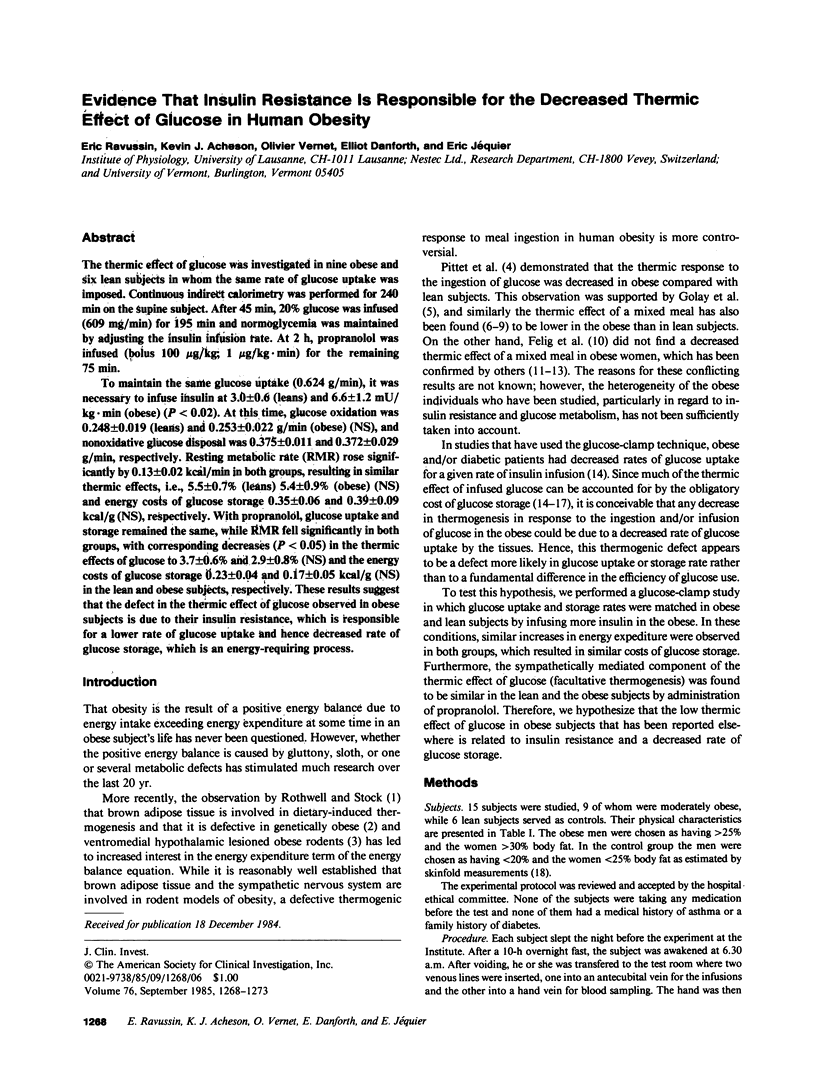
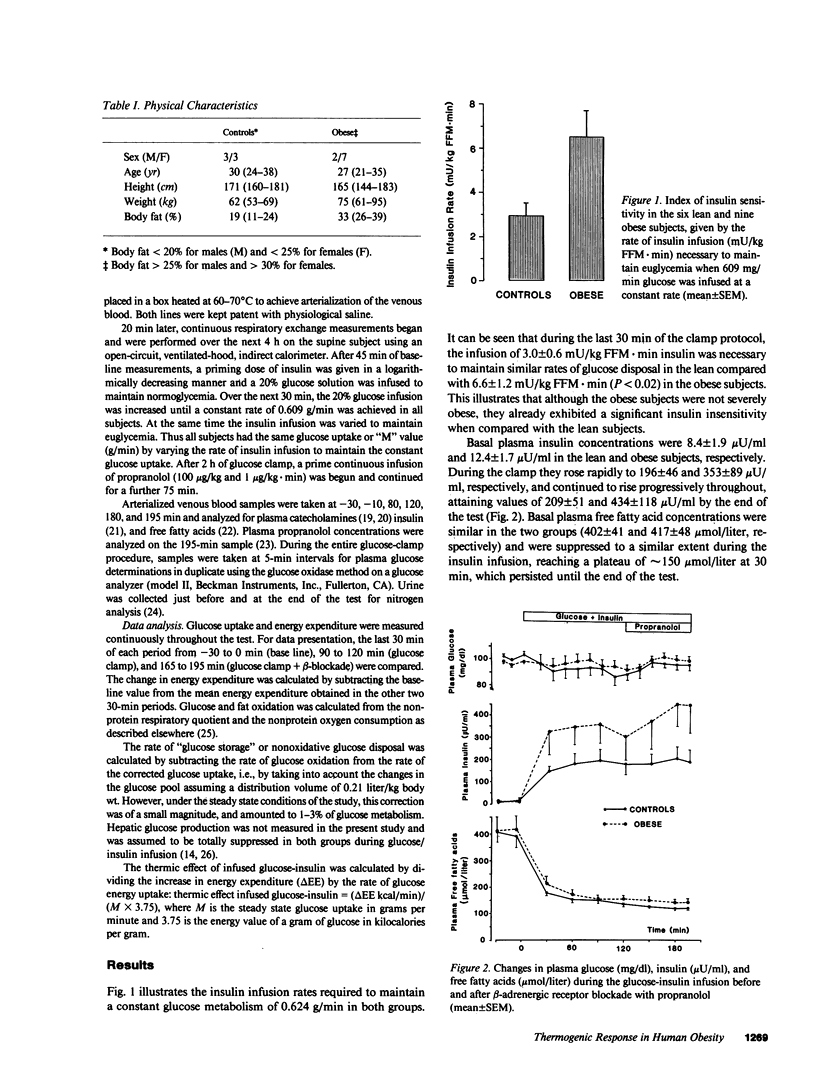
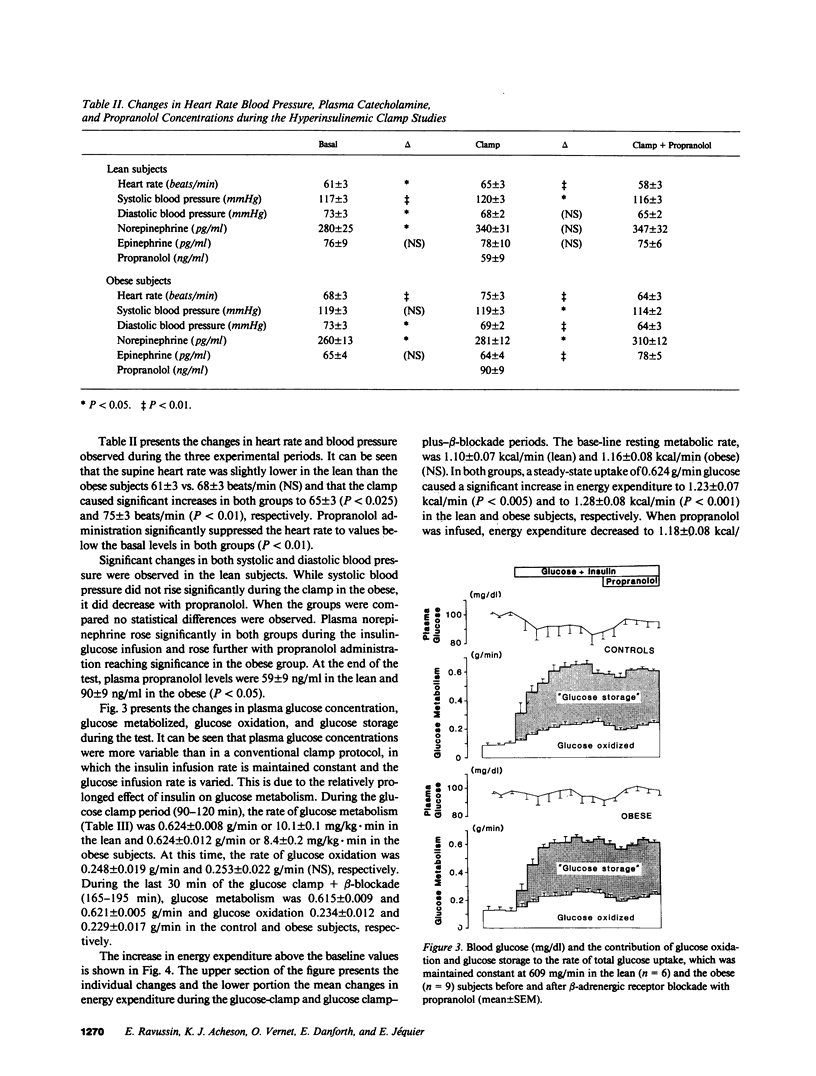
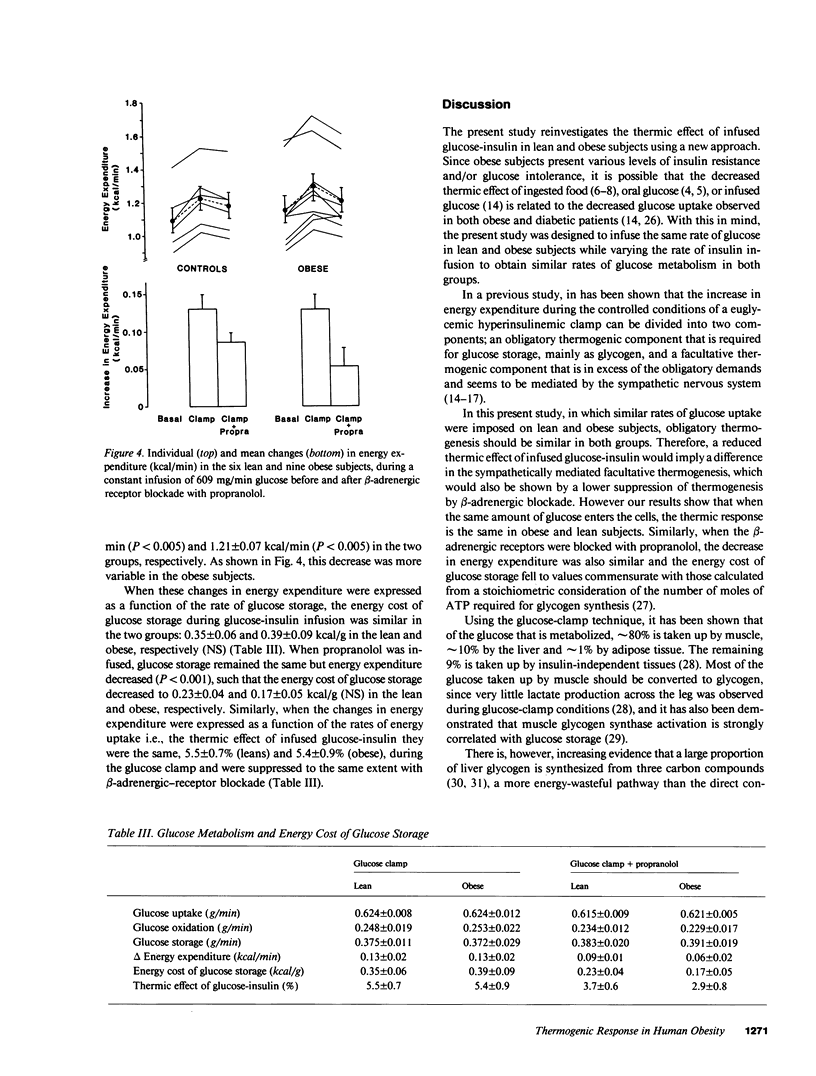
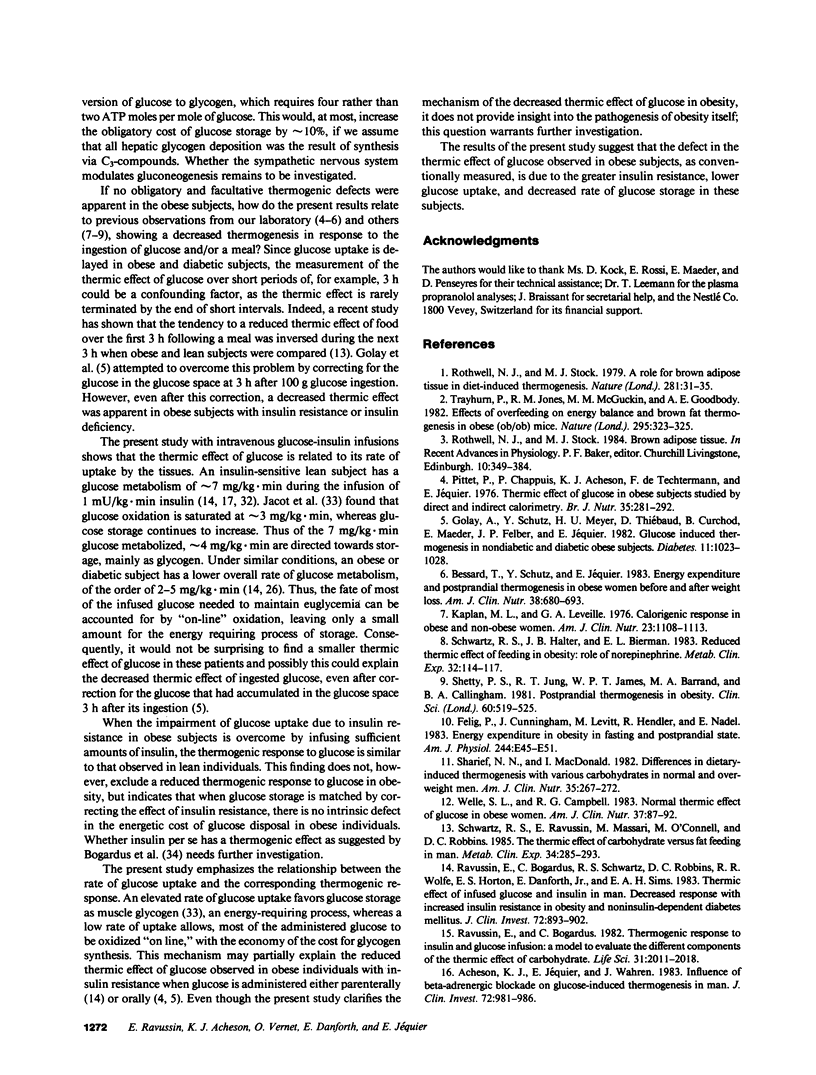
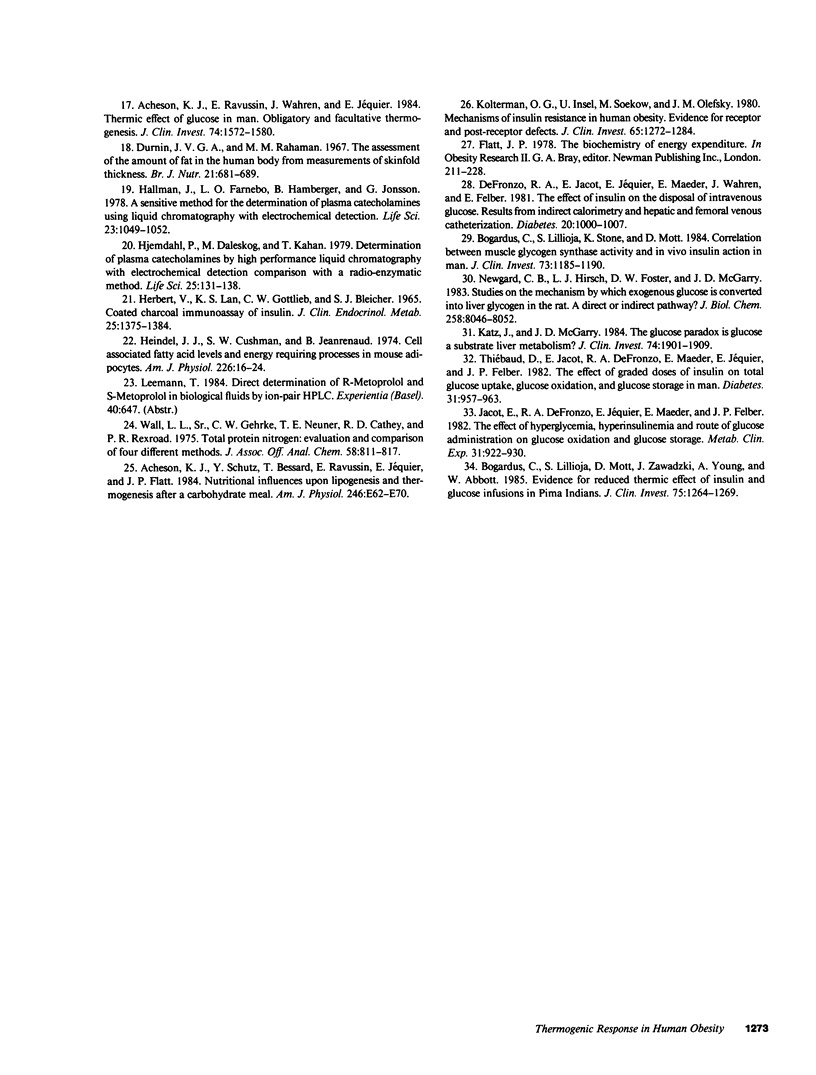
Images in this article
Selected References
These references are in PubMed. This may not be the complete list of references from this article.
- Acheson K. J., Ravussin E., Wahren J., Jéquier E. Thermic effect of glucose in man. Obligatory and facultative thermogenesis. J Clin Invest. 1984 Nov;74(5):1572–1580. doi: 10.1172/JCI111573. [DOI] [PMC free article] [PubMed] [Google Scholar]
- Acheson K. J., Schutz Y., Bessard T., Ravussin E., Jéquier E., Flatt J. P. Nutritional influences on lipogenesis and thermogenesis after a carbohydrate meal. Am J Physiol. 1984 Jan;246(1 Pt 1):E62–E70. doi: 10.1152/ajpendo.1984.246.1.E62. [DOI] [PubMed] [Google Scholar]
- Acheson K., Jéquier E., Wahren J. Influence of beta-adrenergic blockade on glucose-induced thermogenesis in man. J Clin Invest. 1983 Sep;72(3):981–986. doi: 10.1172/JCI111070. [DOI] [PMC free article] [PubMed] [Google Scholar]
- Bessard T., Schutz Y., Jéquier E. Energy expenditure and postprandial thermogenesis in obese women before and after weight loss. Am J Clin Nutr. 1983 Nov;38(5):680–693. doi: 10.1093/ajcn/38.5.680. [DOI] [PubMed] [Google Scholar]
- Bogardus C., Lillioja S., Mott D., Zawadzki J., Young A., Abbott W. Evidence for reduced thermic effect of insulin and glucose infusions in Pima Indians. J Clin Invest. 1985 Apr;75(4):1264–1269. doi: 10.1172/JCI111825. [DOI] [PMC free article] [PubMed] [Google Scholar]
- Bogardus C., Lillioja S., Stone K., Mott D. Correlation between muscle glycogen synthase activity and in vivo insulin action in man. J Clin Invest. 1984 Apr;73(4):1185–1190. doi: 10.1172/JCI111304. [DOI] [PMC free article] [PubMed] [Google Scholar]
- DeFronzo R. A., Jacot E., Jequier E., Maeder E., Wahren J., Felber J. P. The effect of insulin on the disposal of intravenous glucose. Results from indirect calorimetry and hepatic and femoral venous catheterization. Diabetes. 1981 Dec;30(12):1000–1007. doi: 10.2337/diab.30.12.1000. [DOI] [PubMed] [Google Scholar]
- Durnin J. V., Rahaman M. M. The assessment of the amount of fat in the human body from measurements of skinfold thickness. Br J Nutr. 1967 Aug;21(3):681–689. doi: 10.1079/bjn19670070. [DOI] [PubMed] [Google Scholar]
- Felig P., Cunningham J., Levitt M., Hendler R., Nadel E. Energy expenditure in obesity in fasting and postprandial state. Am J Physiol. 1983 Jan;244(1):E45–E51. doi: 10.1152/ajpendo.1983.244.1.E45. [DOI] [PubMed] [Google Scholar]
- Golay A., Schutz Y., Meyer H. U., Thiébaud D., Curchod B., Maeder E., Felber J. P., Jéquier E. Glucose-induced thermogenesis in nondiabetic and diabetic obese subjects. Diabetes. 1982 Nov;31(11):1023–1028. doi: 10.2337/diacare.31.11.1023. [DOI] [PubMed] [Google Scholar]
- Hallman H., Farnebo L. O., Hamberger B., Johnsson G. A sensitive method for the determination of plasma catecholamines using liquid chromatography with electrochemical detection. Life Sci. 1978 Sep 11;23(10):1049–1052. doi: 10.1016/0024-3205(78)90665-3. [DOI] [PubMed] [Google Scholar]
- Heindel J. J., Cushman S. W., Jeanrenaud B. Cell-associated fatty acid levels and energy-requiring processes in mouse adipocytes. Am J Physiol. 1974 Jan;226(1):16–24. doi: 10.1152/ajplegacy.1974.226.1.16. [DOI] [PubMed] [Google Scholar]
- Herbert V., Lau K. S., Gottlieb C. W., Bleicher S. J. Coated charcoal immunoassay of insulin. J Clin Endocrinol Metab. 1965 Oct;25(10):1375–1384. doi: 10.1210/jcem-25-10-1375. [DOI] [PubMed] [Google Scholar]
- Hjemdahl P., Daleskog M., Kahan T. Determination of plasma catecholamines by high performance liquid chromatography with electrochemical detection: comparison with a radioenzymatic method. Life Sci. 1979 Jul 9;25(2):131–138. doi: 10.1016/0024-3205(79)90384-9. [DOI] [PubMed] [Google Scholar]
- Jacot E., Defronzo R. A., Jéquier E., Maeder E., Felber J. P. The effect of hyperglycemia, hyperinsulinemia, and route of glucose administration on glucose oxidation and glucose storage. Metabolism. 1982 Sep;31(9):922–930. doi: 10.1016/0026-0495(82)90183-4. [DOI] [PubMed] [Google Scholar]
- Kaplan M. L., Leveille G. A. Calorigenic response in obese and nonobese women. Am J Clin Nutr. 1976 Oct;29(10):1108–1113. doi: 10.1093/ajcn/29.10.1108. [DOI] [PubMed] [Google Scholar]
- Katz J., McGarry J. D. The glucose paradox. Is glucose a substrate for liver metabolism? J Clin Invest. 1984 Dec;74(6):1901–1909. doi: 10.1172/JCI111610. [DOI] [PMC free article] [PubMed] [Google Scholar]
- Kolterman O. G., Insel J., Saekow M., Olefsky J. M. Mechanisms of insulin resistance in human obesity: evidence for receptor and postreceptor defects. J Clin Invest. 1980 Jun;65(6):1272–1284. doi: 10.1172/JCI109790. [DOI] [PMC free article] [PubMed] [Google Scholar]
- Newgard C. B., Hirsch L. J., Foster D. W., McGarry J. D. Studies on the mechanism by which exogenous glucose is converted into liver glycogen in the rat. A direct or an indirect pathway? J Biol Chem. 1983 Jul 10;258(13):8046–8052. [PubMed] [Google Scholar]
- Pittet P., Chappuis P., Acheson K., De Techtermann F., Jéquier E. Thermic effect of glucose in obese subjects studied by direct and indirect calorimetry. Br J Nutr. 1976 Mar;35(2):281–292. doi: 10.1079/bjn19760033. [DOI] [PubMed] [Google Scholar]
- Ravussin E., Bogardus C., Schwartz R. S., Robbins D. C., Wolfe R. R., Horton E. S., Danforth E., Jr, Sims E. A. Thermic effect of infused glucose and insulin in man. Decreased response with increased insulin resistance in obesity and noninsulin-dependent diabetes mellitus. J Clin Invest. 1983 Sep;72(3):893–902. doi: 10.1172/JCI111060. [DOI] [PMC free article] [PubMed] [Google Scholar]
- Ravussin E., Bogardus C. Thermogenic response to insulin and glucose infusions in man: a model to evaluate the different components of the thermic effect of carbohydrate. Life Sci. 1982 Nov 1;31(18):2011–2018. doi: 10.1016/0024-3205(82)90040-6. [DOI] [PubMed] [Google Scholar]
- Rothwell N. J., Stock M. J. A role for brown adipose tissue in diet-induced thermogenesis. Nature. 1979 Sep 6;281(5726):31–35. doi: 10.1038/281031a0. [DOI] [PubMed] [Google Scholar]
- Schwartz R. S., Halter J. B., Bierman E. L. Reduced thermic effect of feeding in obesity: role of norepinephrine. Metabolism. 1983 Feb;32(2):114–117. doi: 10.1016/0026-0495(83)90214-7. [DOI] [PubMed] [Google Scholar]
- Schwartz R. S., Ravussin E., Massari M., O'Connell M., Robbins D. C. The thermic effect of carbohydrate versus fat feeding in man. Metabolism. 1985 Mar;34(3):285–293. doi: 10.1016/0026-0495(85)90014-9. [DOI] [PubMed] [Google Scholar]
- Sharief N. N., Macdonald I. Differences in dietary-induced thermogenesis with various carbohydrates in normal and overweight men. Am J Clin Nutr. 1982 Feb;35(2):267–272. doi: 10.1093/ajcn/35.2.267. [DOI] [PubMed] [Google Scholar]
- Shetty P. S., Jung R. T., James W. P., Barrand M. A., Callingham B. A. Postprandial thermogenesis in obesity. Clin Sci (Lond) 1981 May;60(5):519–525. doi: 10.1042/cs0600519. [DOI] [PubMed] [Google Scholar]
- Thiebaud D., Jacot E., DeFronzo R. A., Maeder E., Jequier E., Felber J. P. The effect of graded doses of insulin on total glucose uptake, glucose oxidation, and glucose storage in man. Diabetes. 1982 Nov;31(11):957–963. doi: 10.2337/diacare.31.11.957. [DOI] [PubMed] [Google Scholar]
- Trayhurn P., Jones P. M., McGuckin M. M., Goodbody A. E. Effects of overfeeding on energy balance and brown fat thermogenesis in obese (ob/ob) mice. Nature. 1982 Jan 28;295(5847):323–325. doi: 10.1038/295323a0. [DOI] [PubMed] [Google Scholar]
- Welle S. L., Campbell R. G. Normal thermic effect of glucose in obese women. Am J Clin Nutr. 1983 Jan;37(1):87–92. doi: 10.1093/ajcn/37.1.87. [DOI] [PubMed] [Google Scholar]




